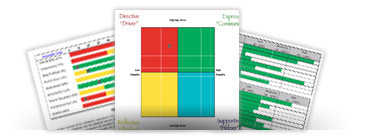Hard or Soft? How your messaging style affects acceptance

Our training programs for sales teams incorporate the latest neuroscience research. Study after study prove that Emotional Intelligence (EQ) is a better harbinger of sales success, more than IQ. This is logical: those with highly developed EQ can better relate to others and gain their trust, and this makes for easier sales.
One important component to EQ is self-awareness. Those with high EQ understand the way they present themselves directly impacts how their messages are received. In contrast, those with low self-awareness turn off many prospective buyers. They don’t adjust their communication style to the situation – and their ideas are rejected.
As selling is basically about creative ideas and solving customer problems, it pays to develop emotional intelligence. High EQ stacks the odds in your favor when dealing with different personality types, each of which communicates in a certain style.
Selling = idea acceptance
The first thing a prospect needs to “buy” in a successful transaction is the idea that they can trust the salesperson. Without acceptance of the messenger, the sales message falls on deaf ears. Let’s explore this a bit more, because it is extremely relevant to sales teams training.
In the book Messengers, written by Stephen Martin and Joseph Marks, the authors explain, “We tend to judge an idea not on its merits, but according to how we judge the person putting it forward. We fail to separate the idea being communicated from the person or entity conveying it…They become the message.”
Martin and Marks posit that there are two main categories of messenger: hard messengers and soft messengers.
Hard messengers leverage traits such as socioeconomic position, competence, dominance and attractiveness to engage others to listen to what they have to say. Their elevated “altitude” or status wins acceptance from their audience.
Soft messengers use warmth, vulnerability, trustworthiness and charisma to achieve the same. Their ideas are accepted because they are great at connecting with people.
One thing the book doesn’t delve into, which is extremely important, is that hard and soft messengers do best when communicating with others of a similar disposition.
We might call hard messengers “A-type personalities” or “Dominant” or “Direct Drivers,” and they win easy acceptance from other dominant or high-achieving people. However, when they try to convey something to more empathetic or emotional people, they and their messages face more resistance.
In contrast, the soft messengers such as the “Supportive Helper” or “Reflective Thinker” achieve greater affinity with other passive personality types. They achieve less success when dealing with dominant types.
Understanding the above is key to building emotional intelligence for sales success, and sales teams training should include modules on identifying one’s own “type” and how to adjust when dealing with contrasting personalities.
Other ways to improve message acceptance
Regardless of whether you practice a hard or soft delivery style or the personality of your buyer, there are some universal actions which can which improve acceptance and therefore increase the chances of a sale.
For example, in Messengers the authors reinforce something which we all know instinctively: the simplest way to build trust is to smile; angry faces are deemed untrustworthy. So, practice smiling more often!
Here’s more:
- Have a positive attitude. Positivity is contagious and persuasive if genuine. Nothing turns off a buyer more than a complainer.
- Dress well. This doesn’t mean the most expensive designer attire; it means clean, pressed clothes, non-scuffed shoes, etc. Avoid cheap watches, too much jewelry, and revealing attire.
- Practice good grooming. The buyer will form their first impression within milliseconds so don’t ruin in with unkempt hair, bad breath, dirty fingernails, and other mistakes.
- Have a firm handshake. Go palm to palm rather than grab the fingers.
- Make eye contact. This should be a relaxed, interested gaze – not a hard stare. If you feel your forehead or eyebrows tensing, smile to release the tension and make your eyes “friendlier.”
- Deepen your voice slightly. People with deeper voices are favored over those with high-pitched squeals.
And finally, leverage an insider (a coach) wherever possible. If you can get someone close to the buyer to sell your ideas for you, you will find much greater acceptance. Never underestimate the power of a personal network and social proof.
In conclusion, keep in mind the first thing a buyer must accept is YOU. Only then will they accept the messages that go along with your presence and buy your solutions. If the messenger is rejected, the chances of a sale are probably less than 10 percent, so this topic should be part of all sales teams training programs.




